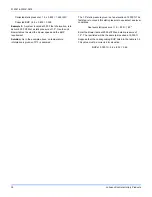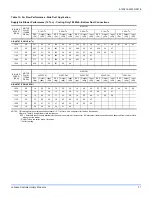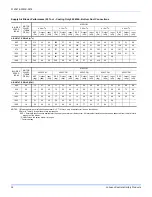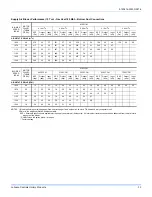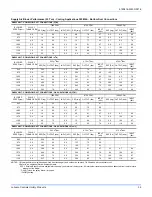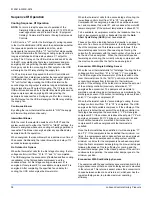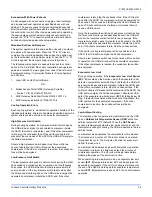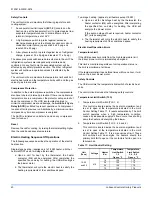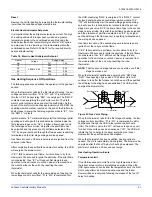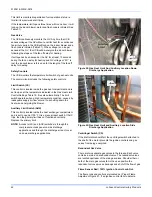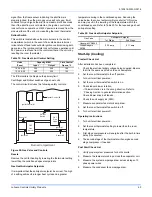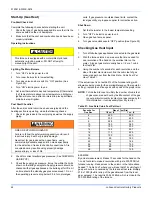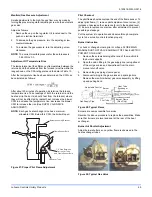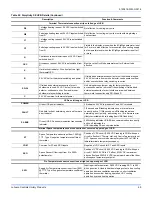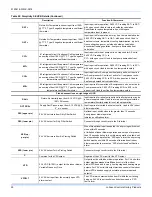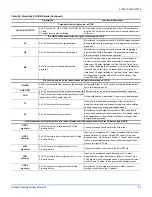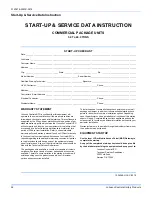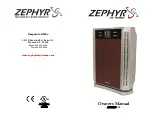
5120416-XIM-C-0216
44
Johnson Controls Unitary Products
Start-Up (Gas Heat)
Pre-Start Check List
Complete the following checks before starting the unit.
1.
Check the type of gas being supplied. Be sure that it is the
same as listed on the unit nameplate.
2.
Make sure that the vent and combustion hoods have been
properly installed.
Operating Instructions
Lighting The Main Burners
1.
Turn “OFF” electric power to unit.
2.
Turn room thermostat to lowest setting.
3.
Turn gas valve knob or switch to “ON” position (See
Figure 29).
4.
Turn “ON” electric power to unit.
5.
Set room thermostat to desired temperature (If thermostat
“set” temperature is above room temperature, pilot burner
ignition will occur and, after an interval to prove pilot flame,
main burners will ignite).
Post Start Checklist
After the entire control circuit has been energized and the
heating section is operating, make the following checks:
1.
Check for gas leaks in the unit piping as well as the supply
piping.
2.
Check for correct manifold gas pressures. (See CHECKING
GAS INPUT.)
3.
Check the supply gas pressure. It must be within the limits
shown on the rating nameplate. Supply pressure should be
checked with all gas appliances in the building at full fire. At
no time should the standby gas pressure exceed 13 in. or
the operating pressure drop below 5.0 in for natural gas
units. If gas pressure is outside these limits, contact the
local gas utility or propane supplier for corrective action.
Shut Down
1.
Set the thermostat to the lowest temperature setting.
2.
Turn “OFF” all electric power to unit.
3.
Open gas heat access panel.
4.
Turn gas valve clockwise to “OFF” position (See Figure 29).
Checking Gas Heat Input
1.
Turn off all other gas appliances connected to the gas meter.
2.
With the furnace turned on, measure the time needed for
one revolution of the hand on the smallest dial on the
meter. A typical gas meter usually has a 1/2 or a 1 cubic
foot test dial.
3.
Using the number of seconds for each revolution and the
size of the test dial increment, find the cubic feet of gas
consumed per hour from the Gas Rate - Cubic Feet Per
Hour Table 21.
If the actual input is not within 5% of the furnace rating (with
allowance being made for the permissible range of the regulator
setting), replace the orifice spuds with spuds of the proper size.
NOTE:
To find the Btu input, multiply the number of cubic feet
of gas consumed per hour by the Btu content of the gas
in your particular locality (contact your gas company for
this information - it varies widely from city to city.).
EXAMPLE
By actual measurement, it takes 13 seconds for the hand on the
1-cubic foot dial to make a revolution with just a 300,000 Btuh
furnace running. Read across to the column in the table above,
headed “1 Cubic Foot”, where you will see that 278 cubic feet of
gas per hour are consumed by the furnace at that rate. Multiply
278 x 1050 (the Btu rating of the gas obtained from the local
gas company). The result is 292,425 Btuh, which is close to the
300,000 Btuh rating of the furnace.
This furnace is equipped with an intermittent pilot and
automatic re-ignition system. DO NOT attempt to
manually light the pilot.
FIRE OR EXPLOSION HAZARD
Failure to follow the safety warning exactly could result
in serious injury, death or property damage.
Never test for gas leaks with an open flame. use a
commercially available soap solution made specifically
for the detection of leaks to check all connections. A fire
or explosion may result causing property damage,
personal injury or loss of life.
Table 21: Gas Rate Cubic Feet Per Hour
Seconds for
One Rev.
Size of Test Dial
1/2 cu. ft.
1 cu. ft.
4
450
900
6
300
600
8
228
450
10
180
360
12
150
300
14
129
257
16
113
225
18
100
200
20
90
180
22
82
164
24
75
150
26
69
138
28
64
129

